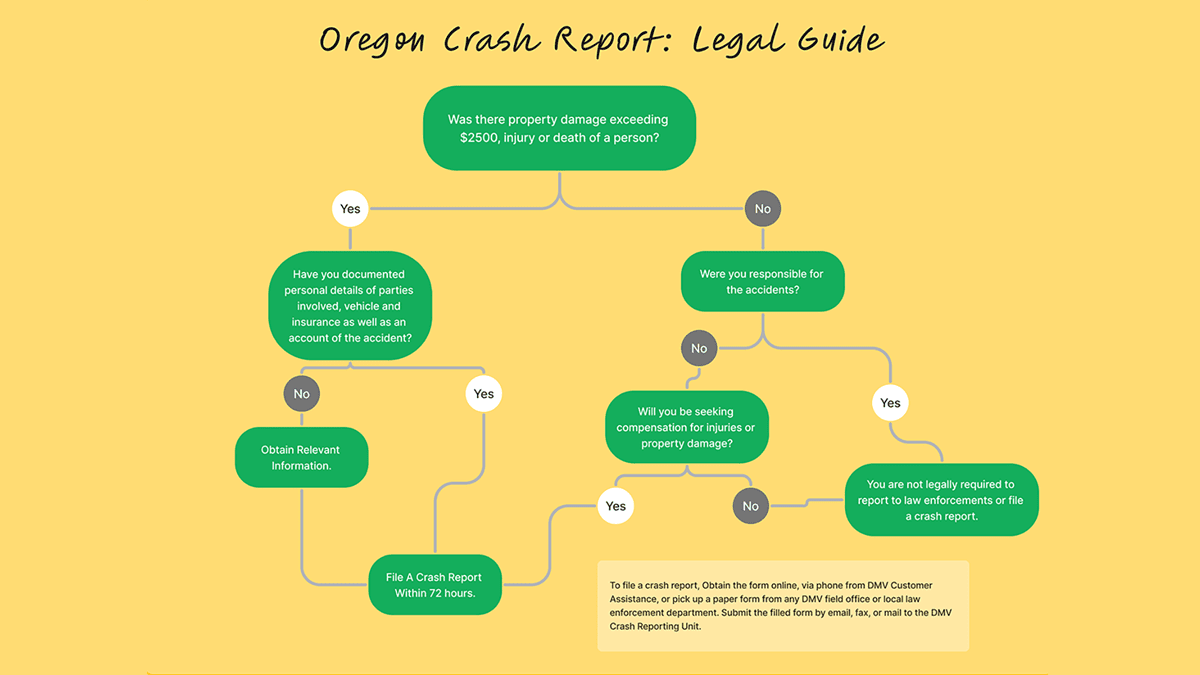09/02/25
7 min
How to File an Oregon Crash Report

Table of Contents
Justice Simplified
Filing an Oregon Crash Report
The aftermath of a motor vehicle accident in Oregon involves several steps, with filing a traffic crash report being among the most crucial. This requirement aims to ensure that all incidents are properly documented and increase the chances of better compensation if filing a claim. Senft Injury Advocates offers this guide to help you understand how to navigate these waters, ensuring compliance and protecting your rights.

Why File a Crash Report in Oregon?
Filing an Oregon crash report isn’t just a bureaucratic step; it’s a vital part of the post-accident process. This report plays a crucial role in:
- Documenting the incident for legal and insurance purposes.
- Facilitating the insurance claims process.
- Serving as an official record that can impact future driving privileges.
When Is Filing Mandatory?
You’re required to file an Oregon Traffic Accident and Insurance Report with the DMV under the following conditions:
- Vehicle damage or other property damage exceeds $2,500.
- Any vehicle is towed from the scene.
- The accident results in injury or death.
Under Oregon law, you must file an accident report with the Oregon Department of Motor Vehicles (DMV) within 72 hours of the accident if it meets certain criteria. A police report does not fulfill the requirement for filing an accident report with the Oregon DMV. Even if a police report has been filed, you must still submit an accident report to the DMV if the accident meets the mandatory reporting criteria.
Preparing To File An Accident Report
To complete the Oregon Traffic Accident and Insurance Report, you’ll need:
- Personal details such as your name, date of birth, driver's license number, and address.
- Comprehensive vehicle information, including the license plate number, registration state, vehicle identification number (VIN), and details about the make and model.
- Your insurance company’s name and your policy number.
Obtaining and Submitting the Form
Obtaining the form is straightforward. You can:
- Obtain online: Oregon Traffic Accident and Insurance Report Form.
- Request a copy via phone from DMV Customer Assistance.
- Pick up a paper form from any DMV field office or local law enforcement department.
For submissions, you can email the form after filling it out. Make sure to save the form to your device to ensure your information is retained. Alternatives to email submission include faxing or mailing to the DMV Crash Reporting Unit. The Oregon Driver and Motor Vehicle Services website provides more detailed instructions on downloading and submitting the form.
Additional Steps Alongside Filing a Crash Report in Oregon
When reporting a traffic accident in Oregon, it’s essential to follow specific steps to ensure that all necessary procedures are adhered to, and your interests are safeguarded. Here are the other steps necessary alongside filing a crash report:
1. Document the Scene
Capture photos of the accident scene, including all vehicles involved, visible damage, and the surrounding area. This documentation is crucial for insurance claims and legal matters as it provides a clear record of the accident.
2. Gather Information
Collect contact details and insurance information from all parties involved in the accident. Additionally, if there are witnesses, their accounts can be invaluable; thus, gather their contact information as well.
3. Notify Your Insurance Company
Contact your insurance company about the accident as soon as possible. Early notification can help facilitate the claims process. Be prepared to provide them with all the information and evidence you have gathered from the scene.
4. Seek Medical Attention
If you suspect any injuries, even if they are not immediately apparent, seek medical attention. Injuries such as whiplash or concussions may not manifest until hours or even days after the accident. Documentation from a medical professional can be critical for insurance claims and legal proceedings.
5. Keep Records
Maintain a comprehensive file of all documents related to the accident. This includes the accident report, correspondence with your insurance company, medical records, receipts for any accident-related expenses, and any other pertinent documentation.
6. Legal Consultation
Consult with a personal injury attorney, particularly if the accident involved significant damage, injuries, or potential litigation. An attorney can offer guidance on how to proceed and ensure that your rights are protected.
Legal Support After an Accident
At Senft Injury Advocates, we’re dedicated to providing legal guidance and unwavering support at every step. Our team can help you navigate the legal process, pursue rightful compensation for your injuries, and address any questions or concerns about what comes next. We specialize in handling accidents involving cars, trucks, motorcycles, and rideshares, offering personalized representation tailored to your unique circumstances. Contact us today for a free consultation, and let us help you move forward with confidence and peace of mind.